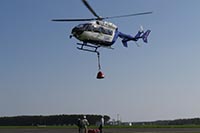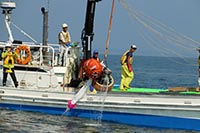Topic of the Month

A photo taken by Takuya Onishi during a night pass over Europe,
framed by the docked Soyuz and Progress spacecraft
(Credit: JAXA/NASA/Takuya Onishi)
Onboard activities of Astronaut Takuya Onishi
In September, Astronaut Takuya Onishi took part in various experiments onboard the International Space Station (ISS), set up new experimental devices in the Japanese Experiment Module ("Kibo"), and also conducted ISS maintenance tasks.
The new experimental devices in Kibo are the Electrostatic Levitation Furnace (ELF) that levitates sample materials using electrostatic force and melts the materials by laser to study their physical properties, and the Group Combustion Experiment Module (GCEM) that will realize Japan's first combustion experiment in space.
On September 7, the crew of Expedition 47/48 returned to Earth. The three crew members of Expedition 48/49--Anatori Ivanishin (Commander), Kathleen Rubins, and Takuya Onishi--are currently living and working on the ISS.

ELF being installed in Multi-purpose Small Payload Rack 2 (MSPR2) in Kibo (September 15)

Preparing the installation rack (MSPR1) of GCEM (September 21)
Photo credits: JAXA/NASA/Takuya Onishi
High-altitude drop test of a simulated small return capsule
On September 21, a drop test of a simulated small return capsule of the H-II Transfer Vehicle "KOUNOTORI" was conducted from an altitude of 2 km.
The simulated capsule was released from a helicopter and splashed down in the designated marine area.
The test was conducted under more realistic conditions and parameters that reflect the design results of the test held last October and those of a later study. The data obtained will be analyzed to realize completion of the HTV small return capsule.

Lifting the capsule (September 21)

Collecting the capsule (September 21)
Kibo This Month
Asian Try Zero G
On September 14, Astronaut Takuya Onishi performed a series of experiments called Asian Try Zero G (ATZ-G).
ATZ-G is a series of simple physical experiments intended to cultivate human resources through utilization of the ISS as a part of activities of the Asia-Pacific Regional Space Agency Forum (APRSAF), and is performed by onboard Japanese astronauts.
For this ATZ-G on an occasion marking its fifth time since its inception, Onishi performed five carefully selected experiment themes in orbit from among more than 120 candidate themes received from students and young scientists/engineers in the Asia-Pacific region.
This time, some of the theme proposers (junior-high school, high school, and university students) from Indonesia, Singapore and Thailand visited the Tsukuba Space Center (TKSC) and actually witnessed their themes being performed in orbit.
Very interesting results were observed, such as how a ball flies (with and without spinning) and how a paper plane flies after one makes certain changes to the aileron and rudder. The theme proposers will study the results, which will be presented at the 23rd APRSAF to be held this November in the Philippines.

Onishi holding a ball for an experiment that observes how the Magnus effect appears (September 14)

Kibo-ABC members and theme proposers monitor the experiment (September 14)
Cooperation Agreement between JAXA and the Republic of Turkey
On September 8, JAXA and the Republic of Turkey signed a new Cooperation Arrangement concerning the utilization of Kibo, and which is intended to promote and embody their mutual cooperation in space.
For JAXA, such cooperation entails providing Turkey with opportunities to deploy a microsatellite (CubeSat) from the Kibo module and conduct material experiments in an exposed environment using the Exposed Experiment Handrail Attachment Mechanism (ExHAM) attached to Kibo's Exposed Facility (EF).
Under this agreement, both parties intend to promote concrete cooperation by utilizing experience in the field of space technology --a practice that JAXA has long followed.
Both parties will further discuss ways to enhance their collaborative relationship in such areas as support for Turkey's plans to establish a space agency, and the promotion of capacity-building activities.
UNOOSA and JAXA open the second round of KiboCUBE

Dr. Koichi WAKATA, ISS Program Manager in JAXA (left), Simonetta Di Pippo, Director of UNOOSA (center), and Professor Mwangi Mbuthia, Dean, Department of Engineering, the University of Nairobi (right)
On September 26, JAXA and the United Nations Office for Outer Space Affairs (UNOOSA) introduced the KiboCUBE program and announced the second opportunity to participate in the program during the 26th International Astronautical Congress (IAC 2016) in Guadalajara, Mexico.
JAXA and UNOOSA launched a three-year "KiboCUBE" program in September 2015, which offered developing countries the opportunity to deploy microsatellites from Kibo.
This initiative aims to contribute to the technological advancement of space activities in developing countries by providing them with the opportunity to deploy microsatellites using the unique capabilities of Kibo.
Samples exposed to the space environment return to researchers
The first samples that had been attached to the ExHAM for exposure in the space environment were returned to Earth in August, and then later handed over to researchers at the TKSC on September 20.
These returned samples are from the following:
- Astrobiology Exposure and Micrometeoroid Capture Experiments (TANPOPO)
Principal Investigator (PI): Akihiko Yamagishi, Tokyo University of Pharmacy and Life Sciences
- Quest for the compositional identification and chemical evolutional understanding of Interstellar Dust (QCC)
PI: Itsuki Sakon, University of Tokyo
Other samples will also be handed over next month.

Prof. Yamagishi (right) receiving the samples

Prof. Sakon (right) receiving the samples
Long-term rearing of mice completed
The rearing mice for 35 days in Kibo has been completed, and the samples were returned to Earth. The bones and muscles of these mice, and their adaptation to a different environment will be studied later from different perspectives.










